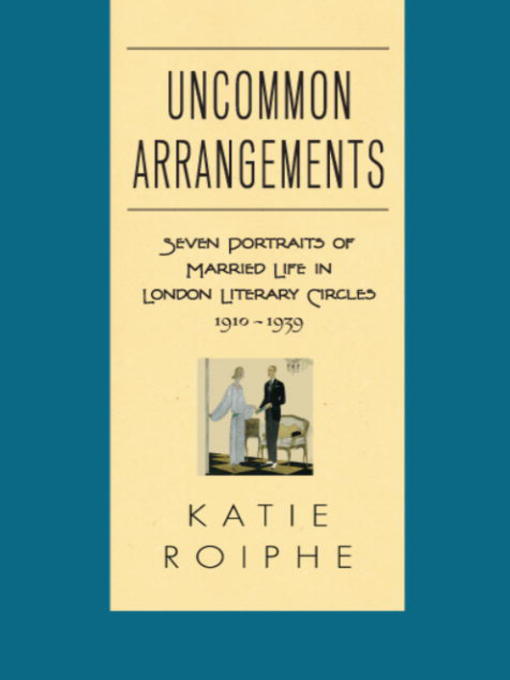
Uncommon Arrangements
Seven Portraits of Married Life in London Literary Circles 1910-1939
کتاب های مرتبط
- اطلاعات
- نقد و بررسی
- دیدگاه کاربران
نقد و بررسی

Starred review from April 2, 2007
In this astute and engrossing examination of seven artsy marriages from 20th-century England, Roiphe (Last Night in Paradise
) couples her penchant for social criticism with her training in English literature (she holds a Ph.D. from Princeton). The book's title is apt, for some of the unions Roiphe describes may strike even today's jaded readers as outré. Feminist writer Vera Brittain proposed that she and her husband, George Catlin, be joined in their household by her dear friend, Winifred Holtby. Katherine Mansfield and John Middleton Murry found that their highly romantic conception of love failed to sustain them through illness and other crises. Roiphe also examines the unions of H.G. Wells and Jane Wells; Elizabeth von Arnim and John Francis Russell; Clive and Vanessa Bell; Ottoline and Philip Morrell; and Radclyffe Hall and Una Troubridge. Roiphe writes not just as a disinterested historian. She wants to know what she can learn from Brittain and the rest about marriage, and the themes Roiphe focuses on remain relevant to 21st-century marriages: is domesticity compatible with long-term emotional engagement, or are marriages destined to become boring? Roiphe finds that once people began to think of marriage as an arrangement that ought to produce human happiness, monogamy was no longer a given. Fans of Pamela Paul and Cathi Hanauer will enjoy this volume, which is vintage Roiphe: provocative, dishy, substantive and fun.

May 15, 2007
Roiphe here presents her vision of "progressive marriage, occurring in literary circles in England]from 1910 to the]Second World War." Her premise is that the couples she examines were highly unusual and innovativewilling to challenge the traditional boundaries of married life and the conventions agreed to by polite society. She chronicles the lives of such well-known figures as H.G. Wells and Katherine Mansfield as well as personalities not so widely recognized today, including Ottoline Morrell and Elizabeth Von Armin. Of the "unconventional domestic portraits" Roiphe offers, the only truly unusual ménage is the household of artist Vanessa Bell. Bell managed an "almost ideal family" consisting of her husband, Clive Bell; abandoned lover Roger Fry; Duncan Grant, the man she lived with; and Grant's lover, David Garnett. The other domestic arrangements examined here are composed largely of husband/wife pairs entangled with a third party and dealing with typical emotions of "jealousy, disappointment and rage." Although Roiphe contends that the people she analyzes believed in their ability to overcome their emotions through reason, she concludes that they were destined to fail. Roiphe herself ultimately fails in her attempt to make a convincing case for this superficial topic. Not a necessary purchase. [See Prepub Alert, LJ 3/1/07.]Kathryn R. Bartelt, Univ. of Evansville Libs., IN
Copyright 2007 Library Journal, LLC Used with permission.

Starred review from June 1, 2007
arriage is perpetually interesting, observes Roiphe. The author of two previous astute books about contemporary sexual mores here extends her fascination with complex human interactions in a set of incisive literary double portraits. Roiphes colorful subjects lived in a time of social ferment as Victorian values crumbled in the wake of World War I and womens lives radically changed. They were given to often excruciating self-analysis as they negotiated daringly and painfully unconventional marriages. Anchoring each biographical sketch to a marital crisis, Roiphe presents a singularly empathic view of the union of the talented and doomed Katharine Mansfield and John Middleton Murry, and dramatic insights into the dynamic between H. G. Wells, his wife, and his pregnant lover, Rebecca West; the marriage and affairs of muse Ottoline Morrell; Radclyffe Halls longtime lesbian relationship; and Vanessa and Clive Bells elastic marriage and its impact on Vanessas sister, Virginia Woolf. Bertrand Russell appears frequently, playing one dicey part in the unforgettable story of the indomitable writer Elizabeth Vonarmin and her awful marriage to Russells monstrous brother. In each tale, Roiphe, inspired aesthetically and philosophically by the writings and lives of these social and artistic pioneers, offers sophisticated psychological, sexual, and social analysis, fashioning uncommonly affecting portraits of uncommon men and women.(Reprinted with permission of Booklist, copyright 2007, American Library Association.)

























دیدگاه کاربران